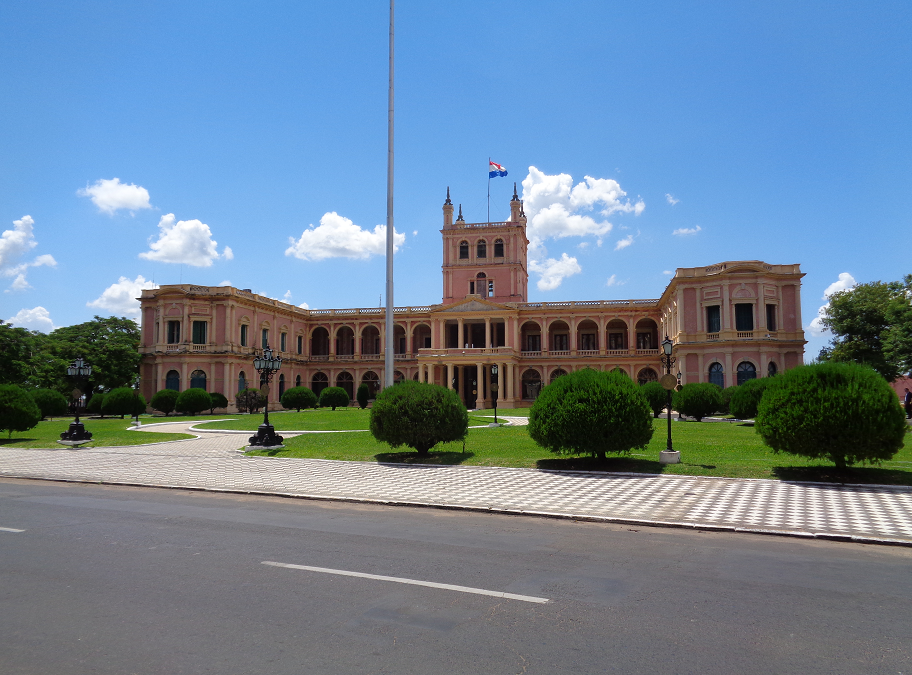Government Palace or Palacio de Gobierno is located in the historic center of Asuncion. It remains a functioning government building being both the seat of government and the official office of the president.
It is a large graceful Neo Classical building built in the style of Versailles. The building is built in the from of a C. There is a large central section which is approached by the staircase that forms to main entrance to the building. This is flanked on either side by wings. A single square tower rises centrally.
The front of the palace faces the streets of central Asuncion. To the rear the palace over looks a large formally kept lawn and beyond that the waters of Asuncion Bay. Being built on high ground standing back from the waterfront the palace is visible from the water at a considerable distance.
As befits such an important building it maintained in fine condition. The palace itself in addition to regular cleaning is repainted from time to time. For a long while the palace was bright white but has now been painted a soft pink.
The lawns riverside of the palace consist of grass and clearly laid out pathways. This avoids obstruction of the view of the river and also allows for a helicopter landing pad. In front of the palace the lawns are laid out with trees and shrubs which guide visitors towards the entrance and add to its appearance.
The Government Palace is also know as Palacio de Lopez. It was constructed in the mid 19th century in the times of the two presidents Lopez.
The first was Carlos Lopez. During his modernizing of Asuncion he felt a presidential palace in the style of those in Europe would be a suitable center piece for his city.
Plans were drawn up and in 1857 the English architect Alan or Alonso Taylor was brought over from Chelsea in London to oversee its construction. No expense was spared on the building of his palace. The finest materials were obtained from across Paraguay and from overseas.
The work took many years to complete. The palace had still not been finished in 1862 when Carlos Lopez died and the presidency of Paraguay passed to his son.
Under Francisco Lopez the son of Carlos Lopez Alonso Taylor continued his work on the building of the palace. This work was further delayed when in dispute with Brazil and Argentina Francisco Lopez went to war. This would also draw in Uruguay on the side of Brazil and Argentina to become the War of the Triple Alliance.
Fortunately by this stage Alonso Taylor had been able to finish the construction. The main structural work had all been completed and just the artistic details and finishing touches were required.
If this had not been the case the work may have been forced to a stop. As he tried to finish the palace his workforce was gradually taken away, enlisted and sent away to fight in the war.
By the time the palace was completed Alonso Taylor had only children left as his workforce. Some of these were as young as six. The palace was though finally completed in 1867, ten years after the work had begun.
Francisco Lopez then had his palace. However with war raging he was never able to use it. In 1869 Asuncion fell to the combined forces of Argentina and Brazil. The newly completed palace was bombed and looted by the conquerors. Then having lost his capital Francisco Lopez began his fighting retreat across Paraguay.
A number of temporary capitals were declared over the following months until the remnants of the Paraguayan forces were defeated and Francisco Lopez killed in one final battle towards the Brazilian border.
After the war once peace had been established and a Paraguayan government reinstalled Asuncion was slowly repaired and rebuilt. One part of this was the repairing of the Presidential Palace which now looks as fine as when Alonso Taylor finally completed his contract.
Since then the palace has become one of the most iconic in Asuncion. Its image used to promote Paraguay and seen upon products across the country. It is one of the most photographed buildings in Asuncion and a must for all tourists and visitors alike.
Sitting as it does in the heart of the historic old town no visit to Asuncion would be complete without a visit to the Government Palace.


Recent Comments